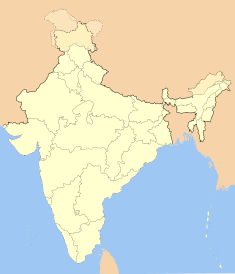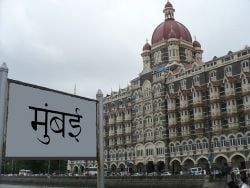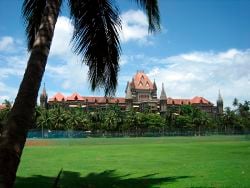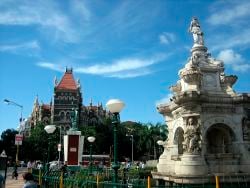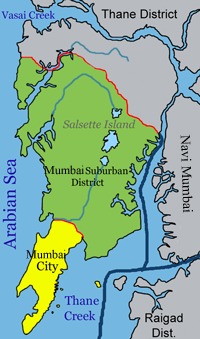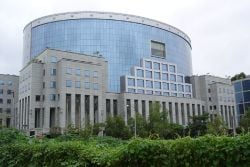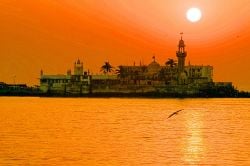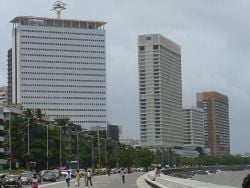| Bombay Mumbai Maharashtra • India | |
| Coordinates: | |
| Time zone | IST (UTC+5:30) |
| Area • Elevation |
603 km² (233 sq mi) • 14 m (46 ft) |
| District(s) | Mumbai City Mumbai Suburban |
| Population • Density • Metro |
12,478,447 (1st) (2011) • 20,694 /km² (53,597 /sq mi) • 20,748,395[1] (1st) (2011) |
| Mayor | Kishori Pednekar |
| Codes • Pincode • Telephone • UN/LOCODE • Vehicle |
• 400 xxx • +9122-XXXX XXXX • IN BOM • MH 01—03 |
| Website: www.mcgm.gov.in | |
Coordinates:
- "Bombay" redirects here.
Mumbai (Marathi: मुंबई, IAST: Mumbaī, IPA: 'mumbəi), formerly known as Bombay, is the the most populous city in India and capital of the state of Maharashtra. Mumbai is located on Salsette Island, off the west coast of India. Along with its neighboring suburbs, it forms the world's fifth most populous metropolitan area with a population of about 20 million.
Mumbai is the commercial and entertainment capital of India, and houses important financial institutions, such as the Reserve Bank of India (RBI), the Bombay Stock Exchange (BSE), the National Stock Exchange of India (NSE) and the corporate headquarters of many Indian companies. Mumbai has attracted migrants from all over India because of the immense business opportunities, and the relatively high standard of living, making the city a potpourri of various communities and cultures. The city is home to India's Hindi film and television industry, known as Bollywood. Mumbai is also one of the few cities that accommodates a national park, the Sanjay Gandhi National Park, within its city limits.
Names
The name “Bombay” is an eponym, etymologically derived from Mumba or Maha-Amba—the name of the Hindu goddess Mumbadevi, and Aai—mother in Marathi.[2] The former name Bombay had its origins in the sixteenth century, when the Portuguese arrived in the area and called the place by various names which finally took on the written form Bombaim, still common in current Portuguese use. After the British gained possession in the seventeenth century, it was anglicized to Bombay, although it was known as Mumbai or Mambai to Marathi and Gujarati-speakers, and as Bambai in Hindi, Urdu, and Persian.[3] The name was officially changed to the Marathi pronunciation of Mumbai in 1995.
A widespread explanation of the origin of the traditional English name Bombay holds that it was derived from a Portuguese name meaning good bay.[4] This is based on the fact that bom is Portuguese for good, and the English word bay is similar to the Portuguese baía (bahia in old spelling). However, the normal Portuguese rendering of good bay would have been bahia boa rather than the grammatically incorrect bom bahia.
Other sources give a different origin for the Portuguese toponym Bombaim. José Pedro Machado's Dicionário Onomástico Etimológico da Língua Portuguesa ("Portuguese Dictionary of Onomastics and Etymology") mentions what is probably the first Portuguese reference to the place, dated from1516, as Benamajambu or Tena-Maiambu,[5] pointing out that "maiambu" seems to refer to Mumba-Devi, the Hindu goddess after which the place is named in Marathi (Mumbai). In that same century the spelling seems to have evolved to Mombayn (1525)[6] and then Mombaim (1563).[7] The final form Bombaim appears later in the sixteenth century, as recorded by Gaspar Correia in his Lendas da Índia ("Legends of India").[8] J.P. Machado seems to reject the "Bom Bahia" hypothesis, asserting that Portuguese records mentioning the presence of a bay at the place led the English to assume that the noun (bahia, "bay") was an integral part of the Portuguese toponym, giving rise to the English version Bombay, adapted from Portuguese.[9]
History
Present-day Mumbai was originally an archipelago of seven islands. Artifacts found near Kandivali, in northern Mumbai, indicate that these islands had been inhabited since the Stone Age. Documented evidence of human habitation dates back to 250 B.C.E., when it was known as Heptanesia (Ptolemy) (Ancient Greek: A Cluster of Seven Islands). In the third century B.C.E., the islands formed part of the Maurya Empire, ruled by the Buddhist emperor, Aşoka. During the first few centuries of our era, control over Mumbai was disputed between the Indo-Scythian Western Satraps and the Satavahanas. The Hindu rulers of the Silhara Dynasty later governed the islands until 1343, when the kingdom of Gujarat annexed them. Some of the oldest edifices of the archipelago – the Elephanta Caves and the Walkeshwar temple complex date from this era.
In 1534, the Portuguese appropriated the islands from Bahadur Shah of Gujarat. They were ceded to Charles II of England in 1661, as dowry for Catherine de Braganza. These islands, were in turn leased to the British East India Company in 1668 for a sum of £10 per annum. The company found the deep harbor on the east coast of the islands to be ideal for setting up their first port in the sub-continent. The population quickly rose from 10,000 in 1661, to 60,000 in 1675. In 1687, the British East India Company transferred its headquarters from Surat to Bombay. The city eventually became the headquarters of the Bombay Presidency. From 1817 onwards, the city was reshaped, with large civil engineering projects aimed at merging all the islands in the archipelago into a single amalgamated mass. This project, known as the Hornby Vellard, was completed by 1845, and resulted in the total area swelling to 438 km² (272 square miles). In 1853, India's first passenger railway line was established, connecting Bombay to the town of Thane. During the American Civil War (1861–1865), the city became the world's chief cotton trading market, resulting in a boom in the economy and subsequently enhancing the city's stature.
The opening of the Suez Canal in 1869 transformed Bombay into one of the largest seaports on the Arabian Sea.[10] Over the next 30 years, the city grew into a major urban center, spurred by an improvement in infrastructure and the construction of many of the city's institutions. The population of the city swelled to one million by 1906, making it the second largest in India after Calcutta. As capital of the Bombay Presidency, it was a major base for the Indian independence movement, and the site from which Mahatma Gandhi launched the Quit India Movement in 1942. After India's independence in 1947, it became the capital of Bombay State. In the 1950 the city expanded to its present limits by incorporating parts of Salsette Island which lies to the north.
After 1955, when the State of Bombay was being reorganized along linguistic lines into the states of Maharashtra and Gujarat, there was a demand that the city be constituted as an autonomous city-state. However, the Samyukta Maharashtra movement opposed this, and insisted that Mumbai be declared the capital of Maharashtra. Following a successful protest, in which 105 people were killed by police fire, Maharashtra state was formed with Mumbai as its capital on May 1, 1960.
The late 1970s witnessed a construction boom and a significant influx of migrants, as a consequence of which Mumbai overtook Kolkata as India's most populous city. The influx of migrants caused unrest among the resident Maharashtrians and led to the creation, in 1966, of the Hindu nationalist Shiv Sena party by Balasaheb Thackeray, to promote the rights of bhumiputra (sons of soil). The city was torn apart in the riots of 1992-1993, when large-scale sectarian violence caused extensive loss of life and property. A few months later, on March 12, a series of co-ordinated bombings at several city landmarks by the Mumbai underworld killed around three hundred people.
In 1995, the city was renamed Mumbai by the Shiv Sena government of Maharashtra, in keeping with their policy of renaming colonial institutions after historic local appellations. In recent years there have been bomb explosions on public transport buses. In 2006, Mumbai was also the site of a major terrorist incident in which over two hundred people were killed when several bombs exploded almost simultaneously on the Mumbai Suburban Railway.[11]
Geography
Mumbai is located on Salsette Island, which lies at the mouth of Ulhas River off the western coast of India, in the coastal region known as the Konkan. Much of Mumbai is just above sea level, and the average elevation ranges from 10 to 15 meters (32.8 – 49 feet). Northern Mumbai is hilly, and the highest point in the city is 450 meters (1,450 feet). Mumbai spans a total area of 468 km² (169 mi²).
Five lakes supply water to Mumbai: Lakes Vihar, Vaitarna, Powai, Tulsi and Tansa. Tulsi Lake, Vihar Lake and Powai Lake are located within the metropolitan limits, the first two within the Borivali National Park, and supply part of the city's drinking water. Mumbai also has three small rivers within the city limits originating in the National Park. The coastline of the city is indented with numerous creeks and bays. The eastern coast of Salsette Island is covered with large mangrove swamps, rich in biodiversity. On the western coast there are two beaches, named Juhu beach and Girgaum Chowpatti.
Soil cover in the city region is predominantly sandy due to its proximity to the sea. In the suburbs, the soil cover is largely alluvial and loamy. The underlying rock of the region is composed of black Deccan basalt flows, and their acid and basic variants date back to the late Cretaceous and early Eocene eras. Mumbai sits on a seismically active zone owing to the presence of three fault lines in the vicinity.[12] The area is classified as a Zone III region, which means an earthquake of up to magnitude 6.5 on the Richter-scale may be expected.
Mumbai is classified as a metropolis of India, under the jurisdiction of the Brihanmumbai Municipal Corporation. It consists of two distinct regions—the city and the suburbs, which also form two separate districts of Maharashtra. The city region is also commonly referred to as the Island City.[13]
Climate
Mumbai lies in the tropical zone, near the Arabian Sea. The climate of the city may be broadly classified into two main seasons—the humid season, and the dry season. The humid season, between March and October, is characterized by high humidity and temperatures of over 30 °C (86 °F). The monsoon rains lash the city from June to September, and supply most of the city's annual rainfall of 2,200 mm (85 inches). The highest annual rainfall ever recorded was 3,452 mm (135.89 inches) in 1954. The highest rainfall recorded in a single day was 944 mm (37.16 inches) on July 26, 2005.[14]
The dry season, between November and February, is characterized by moderate levels of humidity and warm to cool weather. Cold northerly winds are responsible for a mild chill during January and February. Annual temperatures range from a high of 38 °C (100 °F) to a low of 11 °C (52 °F). Mumbai's mean monthly temperature in mid-summer (May) is 33°C (91°F); in mid-winter (January) it drops to 19°C (67°F). Due to humidity and overall weather patterns, people do not suffer from any extremity in weather with exception of some flooding during the monsoon season.
Economy
Mumbai serves as a important economic hub of India. Many of India's numerous conglomerates (including State Bank Of India, Tata Group, Godrej and Reliance), and four of the Fortune Global 500 companies are based in Mumbai. Many foreign banks and financial institutions also have branches in this area.
Up until the 1980s, Mumbai owed its prosperity largely to textile mills and the seaport, but the local economy has since been diversified to include engineering, diamond-polishing, healthcare and information technology.
Mumbai’s status as the state capital means that state and central government employees make up a large percentage of the city's workforce. Mumbai also has a large population of unskilled and semi-skilled laborers, who primarily earn their livelihood as hawkers, taxi drivers, mechanics and other blue collar professions. The port and shipping industry, too, employs many residents, directly or indirectly.
The media industry is the other major employer in Mumbai. Most of India's major television and satellite networks, as well as its major publishing houses, are headquartered here. The center of the Hindi movie industry, Bollywood, is located in Mumbai, and the name Bollywood is a portmanteau of Bombay and Hollywood, the center of the American film industry. Marathi television and the Marathi film industry are also based in Mumbai.
Along with the rest of India, Mumbai, its commercial capital, has witnessed an economic boom since the liberalization of 1991, the finance boom in the mid-1990s and the IT, export, services and BPO boom in this decade. The middle class in Mumbai is the segment most impacted by this growth and is the driver behind the consequent growth in consumer spending, fueled by upward mobility among Mumbaikars.
In a survey compiled by Mastercard Worldwide, Mumbai has been ranked 10th among the world's biggest centers of commerce in terms of the financial flow volumes, which takes into consideration the size of its financial services network, besides equity, bond, derivatives and commodity contract transactions.
Civic Administration
The city is administered by the Brihanmumbai Municipal Corporation (BMC) (formerly the Bombay Municipal Corporation), with executive power vested in the Municipal Commissioner, who is an IAS officer appointed by the state government. The Corporation comprises 227 directly-elected Councilors representing the twenty four municipal wards, five nominated Councilors, and a titular Mayor. The BMC is in charge of the civic and infrastructure needs of the metropolis. An Assistant Municipal Commissioner oversees each ward for administrative purposes. Almost all the state political parties field candidates in the elections for Councilors.
The metropolitan area forms two districts of Maharashtra, with each district under the jurisdiction of a District Collector. The Collectors are in charge of property records and revenue collection for the Central Government, and oversee the national elections held in the city.
The Mumbai Police is headed by a Police Commissioner, who is an IPS officer. The Mumbai Police comes under the state Home Ministry. The city is divided into seven police zones and seventeen traffic police zones, each headed by a Deputy Commissioner of Police. The Traffic Police is a semi-autonomous body under the Mumbai Police.
Mumbai is the seat of the Bombay High Court, which exercises jurisdiction over the states of Maharashtra and Goa, and the Union Territories of Daman and Diu and Dadra and Nagar Haveli. Mumbai also has two lower courts, the Small Causes Court for civil matters, and the Sessions Court for criminal cases.
The city elects six members to the Lok Sabha and 34 members to the Maharashtra Vidhan Sabha (State assembly).
Demographics
The population of Mumbai is about 12 million, with the population of the urban agglomerate exceeding 20 million.[1] The religions represented in Mumbai include Hindus (the majority), Muslims, Christians, and Jains. There are also small numbers of Parsis, Buddhists, Sikhs, Jews, and atheists.
Mumbai has a large polyglot population like any other metropolitan city of India. Marathi, the official language of Maharashtra state, is widely spoken. Other languages spoken are Hindi and English. A colloquial form of Hindi, known as Bambaiya – a blend of Marathi, Hindi, Indian English and some invented colloquial words, is spoken on the streets. English is extensively spoken, and is the principal language of the city's white collar workforce.
Like other large cities in the developing world, Mumbai suffers from the same major urbanization problems seen in many fast growing cities in developing countries—widespread poverty and poor public health, unemployment, civic and educational standards for a large section of the population. With available space at a premium, Mumbai residents often reside in cramped, relatively expensive housing, usually far from workplaces, and therefore requiring long commutes on crowded mass transit, or clogged roadways. A significant portion of the population lives in shantytowns and slums.
People and Culture
A resident of Mumbai is called a Mumbaikar, or Bombayite. Many residents live close to major railway stations for easy access to their workplaces, as a significant amount of time is spent on daily commuting. Many residents live a fast-paced life. Mumbai residents celebrate Indian and Western festivals with great fanfare. Among the popular festivals celebrated in the city are Ganesh Chaturthi, Navratri, Diwali, Holi, Ramazan, Dahi Handi, and Mount Mary Carnival.
The metropolis has its own local roadside fast food, comprising vada pav (leavened wheat bread split in half, with fried dumplings as filling), panipuri (deep fried crêpe with tamarind and lentil sauce), paav bhaji (leavened wheat bread accompanied with fried vegetables), sandwich (white sandwich bread with butter, hot sauce (chutney), tomato, potatoes, onions, cucumber and beetroot) and bhelpuri (puffed rice mixture), while South Indian and Indian Chinese are also very popular.
Mumbai is the birthplace of Indian cinema (Dadasaheb Phalke laid the foundations with his silent movies followed by his Marathi talkies), with the oldest film broadcast here in the early twentieth century. Mumbai also boasts large number of cinemas, including the IMAX dome theatre which feature mainstream Bollywood, Marathi, and Hollywood movies. Many film festivals are avidly attended throughout the year. Besides catering to cinephiles, the city has a thriving theatrical tradition in Marathi, Hindi, English and other regional languages. Contemporary art is well represented in both government funded art spaces and private commercial galleries. The government funded art galleries include The Jehangir Art Gallery and The National Gallery of Modern Art. Built in 1833, the Asiatic Society of Bombay is the oldest public library in the city.
Mumbai has two UNESCO World Heritage Sites, the Chhatrapati Shivaji Terminus (formerly Victoria Terminus) (2004) and the Elephanta Caves (1987).[15]
Mumbai has six sister cities (the maximum permitted by the Indian government). They are: Berlin, London, Los Angeles, Saint Petersburg, Stuttgart and Yokohama.
Media
Mumbai has numerous newspaper publications and television and radio stations – Popular English language newspapers published and sold in Mumbai include the Times of India, Mid-day, DNA, Hindustan Times, Mumbai Mirror and Indian Express. Marathi newspapers include Loksatta, Sakal, Lokmat and Maharashtra Times. Newspapers are also printed in other Indian languages. Mumbai is home to India's oldest newspaper, Bombay Samachar, which has been published in Gujarati and English since 1822. Bombay Darpan - the first Marathi newspaper - was started by Bal Shastri Jambhekar in Mumbai on January 6, 1832.[16] Popular magazines are Saaptahik Sakaal, Lokprabha in Marathi and India Today, Outlook in English.
The national television broadcaster, Doordarshan, provides two free terrestrial channels, while three main cable networks serve most households. Zee Marathi, ETV Marathi, DD Sahyadri, Zee TV, Star plus and news channels are popular. Satellite television (DTH) has yet to gain mass acceptance, due to high installation costs. Mumbai households receive over a hundred television channels via cable, and a majority of them are produced to cater to the city's polyglot populace. The metropolis is also the hub of many international media corporations, with many news channels and print publications having a major presence.
There are 12 radio stations in Mumbai, with nine broadcasting on the FM band, and three All India Radio stations broadcasting on the AM band.
Education
Schools in Mumbai are either "municipal schools" (run by the BMC) or private schools (run by trusts or individuals), which in some cases receive financial aid from the government. The schools are affiliated either with the Maharashtra State Board (MSBSHSE), the all-India Indian Certificate of Secondary Education (ICSE), or the Central Board for Secondary Education (CBSE) boards. Marathi or English is the usual language of instruction. The government run public schools lack many facilities, but are the only option for poorer residents who cannot afford the more expensive private schools. A majority of residents prefer private schools because they usually have a better infrastructure and use English as a medium of instruction.
Under the 10+2+3/4 plan, students complete ten years of schooling, and then enroll for two years in Junior College, where they select one of three streams: arts, commerce or science. This is followed by either a general degree course in a chosen field of study, or a professional degree course, such as law, engineering, medicine etc. Most colleges in the city are affiliated with the University of Mumbai, one of the largest universities in the world in terms of the number of graduates. The Indian Institute of Technology, Bombay, one of India's premier engineering schools, VJTI (Veermata Jijabai Technological Institute), SNDT Women's University and Tata Institute of Social Sciences are the other universities in Mumbai.
Mumbai is home to two of India's important research institutions – The Tata Institute of Fundamental Research (TIFR), and the Bhabha Atomic Research Centre (BARC).
Sports
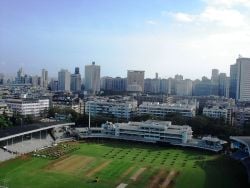
Cricket is the most popular sport in the city, and is usually played in the maidans (grounds) around the city. Gully cricket, a modified form of cricket, is played in the narrow by-lanes of the city, especially on Sundays. Mumbai has produced several famous international cricketers, and is home to the Board of Control for Cricket in India (BCCI). International cricket is widely watched, and the city comes to a virtual standstill on days when the Indian cricket team plays important matches. The local Mumbai cricket team is among the strongest competitors and is the most successful team in the Ranji Trophy, the nation's top domestic cricketing circuit. The city has two international cricket stadiums, the Wankhede Stadium and the Brabourne Stadium. The Wankhede stadium will host the final of 2011 Cricket World Cup.
Football (soccer) is the second most popular sport with the city clubs playing during the monsoons, when other outdoor sports cannot be played. The Football World Cup is one of the most widely watched television events in Mumbai. India's national sport, field hockey, has gone into a sharp decline in the recent years, losing out in terms of popularity to cricket, though many Mumbai players play in the national team.
Other sports are mostly played in the numerous clubs and gymkhanas, and include tennis, squash, billiards, badminton, table tennis and golf. Mumbai also plays Rugby, one of the few Indian cities to do so. Every February, Mumbai holds the Derby races in the Mahalaxmi Racecourse. The event sees many of the city's glitterati attending, arrayed in the latest fashions. In recent times Formula 1 racing has also caught the public's attention, and Mumbai is one of the many Indian cities trying to become part of the worldwide circuit. In March 2004, Mumbai Grand Prix was held as part of the F1 powerboat world championship. Other sports such as volleyball and basketball are mostly popular in schools and colleges.
In 2004, the Mumbai Marathon, an annual marathon event, was established in a bid to bring the sport to the Indian public. Since 2006, Mumbai has also played host to the Kingfisher Airlines Tennis Open, which is an International Series tournament of the ATP Tour.
Transport
Most of Mumbai's inhabitants rely on public transport to travel to and from their workplaces. The city is the headquarters of two railway zones – the Central Railway (CR) headquartered at Chhatrapati Shivaji Terminus (formerly known as Victoria Terminus), and the Western Railway (WR) headquartered near Churchgate. The backbone of the city's transport, the Mumbai Suburban Railway, is composed of three separate networks running the length of the city, in a north-south direction. The Western Railway runs along the western region of the city, while the Central Railway covers most of the central and northeast parts of the metropolis. Both lines extend into the exurbs, each covering a total one-way length of around 125 km (77.67 miles). The Harbour Line is a sub-division of the Central Railway, covering a distance of 54 km along the south-eastern section of the city, near the docks, and extending into Navi Mumbai (New Mumbai). Mumbai is well connected by the Indian Railways to most parts of India through trains that originate from Chhatrapati Shivaji Terminus (formerly Victoria Terminus), Dadar, Lokmanya Tilak Terminus, Mumbai Central and Bandra terminus. Mumbai's suburban rail systems carry a total of 2.2 billion passengers every year.
Public buses run by Bombay Electricity Supply Transport (BEST, an autonomous body under the BMC) cover almost all parts of the metropolis, as well as parts of Navi Mumbai and Thane. Buses are used for commuting short to medium distances, while train fares are more economical for long distance commutes. The BEST fleet consists of single-decker, double-decker and air-conditioned buses.
Black-and-yellow metered taxis, accommodating up to four passengers with luggage, cover most of the metropolis. Auto rickshaws, allowed to operate only in the suburban areas, are the main form of hired transport here. These three-wheeled vehicles can accommodate up to three passengers.
Mumbai's Chhatrapati Shivaji International Airport (formerly, Sahar International Airport) is the busiest airport in India, and caters to cargo and passenger flights. It has two distinct terminals; the domestic terminal commonly called Santacruz Airport situated between the suburbs of Vile Parle and Santacruz, and the international terminal (still popularly called Sahar Airport), situated in the eastern Andheri suburbs. The Juhu aerodrome, India's first airport, now hosts a flying club and a heliport. A proposed Navi Mumbai International Airport, being constructed in the Kopra-Panvel area, will help relieve the increasing traffic burden on the existing airport.
With its unique topography, Mumbai has one of the best natural harbors in the world, handling 50 percent of the country's passenger traffic, and much of India's cargo. It is also an important base for the Indian Navy, and the headquarters of the Western Naval Command. Ferries from Ferry Wharf allow cheap access to islands and beaches in the area.
Utility Services
The BMC supplies potable water to the city, most of which comes from the Tulsi and Vihar lakes, as well as a few lakes further north. The water is filtered at Bhandup, which is Asia's largest water filtration plant. The BMC is also responsible for the road maintenance and garbage collection in the city. Almost all of Mumbai's daily refuse is transported to dumping grounds in Gorai in the northwest, Mulund in the northeast, and Deonar in the east. Sewage treatment is carried out at Worli and Bandra.
Electricity is provided by BEST in the city, and by Reliance Energy, Tata Power, and Mahavitaran (Maharashtra State Electricity Distribution Co. Ltd) in the suburbs. Most of the city's electricity is hydroelectric and nuclear based. Consumption of electricity is growing faster than production capacity. The largest telephone service provider is the state-owned MTNL, which held a monopoly over fixed line and cellular services up until 2000. Cell phone coverage is extensive, and the main service providers are Hutch Essar, Airtel, BPL group, Reliance Communications and Tata Indicom.
Since 1995, many parts of the city also have access to piped gas, provided by Mahanagar Gas Limited, which also provides compressed natural gas to 127 gas stations.
Notes
- ↑ 1.0 1.1 Mumbai Population World Population Review. Retrieved November 11, 2020.
- ↑ Samuel Sheppard, Bombay Place-Names and Street-Names (Bombay: The Times Press, 1917), 104–105.
- ↑ Sujata Patel, "Bombay and Mumbai: Identities, Politics and Populism." in Sujata Patel and Jim Masselos, (eds.), Bombay and Mumbai: The City in Transition (Delhi: Oxford University Press, 2003), 4.
- ↑ By any other name The Mumbai Pages. Retrieved November 11, 2020.
- ↑ Duarte Barbosa, "Livro em que dá relação do que viu e ouviu no Oriente," 1516, apud Machado, J.P., Dicionário Onomástico Etimológico da Língua Portuguesa.
- ↑ Documents from the "Tombo do Estado da Índia" (currently the Historical Archives of Goa or Goa Purabhilekha).
- ↑ Garcia da Orta, "Colóquios dos Simples e Drogas da Índia," original edition 1565, referenced edition 1891–1895, apud Machado, J.P., Dicionário Onomástico Etimológico da Língua Portuguesa.
- ↑ Gaspar Correia, "Lendas da Índia," originally from the sixteenth century, the text was published only in 1858 and 1866.
- ↑ José Pedro Machado, Dicionário Onomástico Etimológico da Língua Portuguesa. entry "Bombaim," volume I, 265/266.
- ↑ Mariam Dossal, Imperial Designs and Indian Realities: The Planning of Bombay City 1845–1875 (Delhi: Oxford University Press, 1991).
- ↑ Special Report: Mumbai Train Attacks BBC News, September 30, 2006. Retrieved November 11, 2020.
- ↑ The Seismic Environment of Mumbai. Retrieved November 11, 2020.
- ↑ Noel Murphy, Evolutionary Mumbai: Making of the "Island City" August 19, 2013.
- ↑ Three drown as heavy rain lashes Mumbai for the 3rd day, DNA India, July 3, 2006. Retrieved November 11, 2020.
- ↑ India: World heritage sites centre. UNESCO. Retrieved November 11, 2020.
- ↑ Mrinal Chatterjee, History of Marathi Journalism Press Institute of India, April 30, 2016. Retrieved November 11, 2020.
ReferencesISBN links support NWE through referral fees
- Agarwal, Jagdish. Bombay - Mumbai: A Picture Book. Wilco Publishing House, 1998. ISBN 8187288353
- Chaudhari, K.K. History of Bombay. Modern Period Gazetteers Dept., Govt. of Maharashtra, 1987.
- Contractor, Behram. From Bombay to Mumbai. Oriana Books, 1998.
- Dossal, Mariam. Imperial Designs and Indian Realities. The Planning of Bombay City 1845–1875. Delhi: Oxford University Press, 1991.
- Dwivedi, Sharada, and Rahul Mehrotra. Bombay, The Cities Within. India Book House Pvt. Ltd., 1995. ISBN 818502880X
- Fox, Edmund A. Short History of Bombay Presidency. Thacker & Co., 1887.
- Katiyar, Arun & Namas Bhojani. Bombay, A Contemporary Account. Harper Collins, 1996. ISBN 8172232160
- MacLean, James Mackenzie. A Guide to Bombay. Various editions, 1875 and& 1902..
- Mappls. Satellite based comprehensive maps of Mumbai. CE Info Systems Ltd., 1999. ISBN 8190110802
- Mehta, Suketu. Maximum City: Bombay Lost and Found. Knopf, 2004. ISBN 0375403728
- Our Greater Bombay. Maharashtra State Bureau of Textbook Production and Curriculum Research, 1990.
- The Oxford School Atlas, 28th Revised Edition. Oxford University Press, 1991. ISBN 0195633164
- Patel, Sujata, and Alice Thorner. Bombay, Metaphor for Modern India. Oxford University Press, 1995. ISBN 0195636880
- Patel, Sijata, and Jim Masselos, (eds.) Bombay and Mumbai: The City in Transition. Delhi: Oxford University Press, 2003.
- Sheppard, Samuel Townsend. Bombay Place-names and Street-names; an Excursion Into the By-ways of the History of Bombay City. Franklin Classics, 2018. ISBN 978-0343133313
- Tindall, Gillian. City of Gold. Penguin, 1992. ISBN 0140095004
- Virani, Pinki. Once was Bombay. Viking, 1999. ISBN 0670888699
External Links
All links retrieved November 10, 2022.
- Mumbai Pages
- Mumbai Lonely Planet
- A local’s guide to Mumbai The Washington Post
| |||||||||||||
| |||||
| |||||
| |||||
Credits
New World Encyclopedia writers and editors rewrote and completed the Wikipedia article in accordance with New World Encyclopedia standards. This article abides by terms of the Creative Commons CC-by-sa 3.0 License (CC-by-sa), which may be used and disseminated with proper attribution. Credit is due under the terms of this license that can reference both the New World Encyclopedia contributors and the selfless volunteer contributors of the Wikimedia Foundation. To cite this article click here for a list of acceptable citing formats.The history of earlier contributions by wikipedians is accessible to researchers here:
The history of this article since it was imported to New World Encyclopedia:
Note: Some restrictions may apply to use of individual images which are separately licensed.

